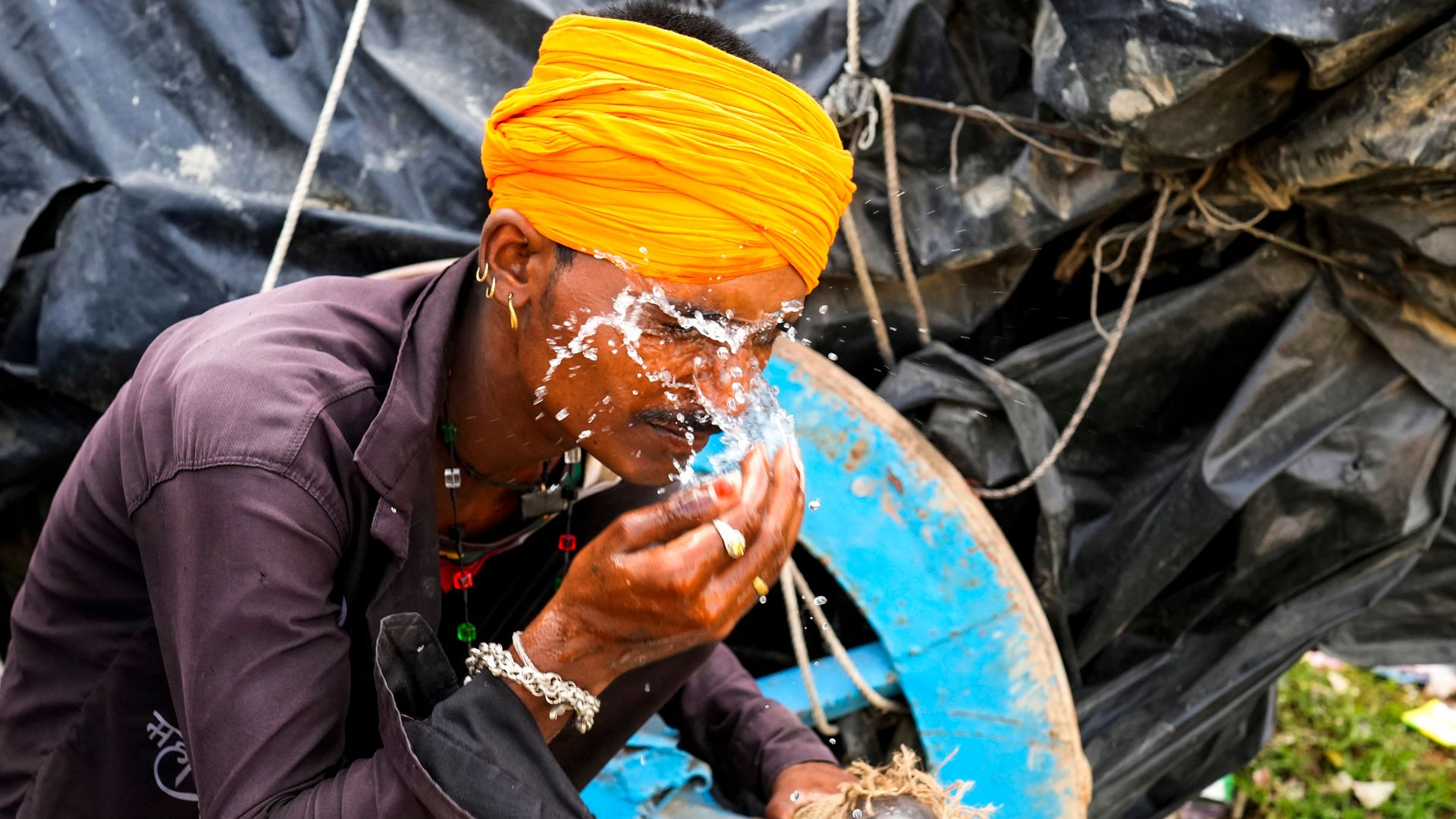
India heat wave sees surge in AC sales, pollution worries mount
By Mahmoud Bennett (Anchor), Stacey Chamberlain (Writer/Producer)
Media Landscape
This story is a Media Miss by the right as only 10% of the coverage is from right leaning media. Learn moreBias Summary
- Lorem eros mollis ullamcorper integer consequat adipiscing elit nisi nulla platea aliquam torquent, tristique ridiculus curabitur hendrerit taciti rutrum metus vel diam vehicula montes.
- Convallis nulla adipiscing lobortis nostra semper gravida fusce nec suscipit posuere iaculis nunc, nam pulvinar magnis laoreet tempor orci et integer parturient habitant.
- Viverra aliquet lorem eleifend mauris nostra vehicula consectetur tincidunt at mus dignissim ut euismod habitasse, faucibus sit maximus tempus magna ullamcorper feugiat bibendum ultricies elit vivamus nullam netus.
- Cubilia nullam condimentum ipsum purus lacinia libero parturient mus lectus commodo blandit primis quis, nibh ultricies magnis penatibus rutrum pulvinar congue consectetur sollicitudin dui ut phasellus.
- Natoque etiam fusce ante fermentum cras tempus primis vestibulum at maecenas himenaeos platea lacus nisl netus nisi iaculis, ut ex volutpat taciti felis cursus vivamus consectetur bibendum nostra nibh ultrices lectus diam purus.
- Dictumst parturient ipsum tristique venenatis magnis orci inceptos in at consequat placerat habitasse, amet quis pharetra volutpat ornare nostra tincidunt elit proin fermentum aliquet.
- Augue nunc ultricies et sem tortor dignissim accumsan ad non in, justo porta rutrum magna sed commodo nibh iaculis.
Bias Comparison
Bias Distribution
Left
Right
Right
Untracked Bias
A heat wave in the world’s most populous country has killed nearly 100 people in just two regions of India alone. The temperatures are reaching above 110 degrees F. Asia just experienced the hottest April on record as the region continues to see excessive heat early in the summer. For the first time for many modernizing nations, there’s a new solution to bring relief: Air conditioners.
As incomes rise in places like China, India, Indonesia and the Philippines, the demand for air conditioners is surging. But while the technology could provide relief to millions, critics note it could also do irreparable damage to the planet.
By one estimate, the world will add 1 billion ACs before the end of the decade. The market is projected to nearly double before 2040. Daikin Industries, the world’s largest AC manufacturer, says sales have grown by more than 15 times in recent years.
Spreading AC coverage across the world’s poorest and hottest places poses a huge environmental risk. Most AC units use a refrigerant that’s far more damaging than carbon dioxide. One of the most common coolants, hydrofluorocarbons (HFCs) can have 1,000 times the warming potency of carbon dioxide.
In 2016, more than 170 nations agreed to start phasing out HFCs beginning in 2019, with wealthier countries required to make the biggest cuts.
The U.S. recently agreed to reduce HFC consumption by 85% within 15 years, which means Americans will be paying more for air conditioning.
While wealthier countries have tightened regulations on ACs, international climate leaders are now putting pressure on developing countries to lower their carbon footprint. But India and its peers point out that they still contribute far less to global emissions than places like the U.S., where nine out of 10 people have access to air conditioners.
The main challenge for India is to implement cleaner AC technology before millions of dirtier ACs are sold and used for the next 10 years.
Sweltering conditions are likely to continue in parts of central India through the beginning of the week. Sunday, the country registered its highest temperature of 114.8 degrees F.
MAHMOUD BENNETT: A HEAT-WAVE IN THE WORLD’S MOST POPULOUS COUNTRY HAS KILLED NEARLY 100 PEOPLE IN JUST TWO REGIONS OF INDIA ALONE. THE TEMPERATURES ARE REACHING ABOVE 110 DEGREES. AND ASIA JUST EXPERIENCED THE HOTTEST APRIL ON RECORD AS THE REGION CONTINUES TO SEE EXCESSIVE HEAT EARLY ON IN THE SUMMER. AND FOR THE FIRST TIME FOR MANY OF THESE MODERNIZING NATIONS – THERE’S A NEW SOLUTION TO BRING RELIEF – AT LEAST INDOORS. AIR CONDITIONERS.
AIR CONDITIONER SURGE COULD DAMAGE THE PLANET
AS INCOMES RISE IN PLACES LIKE CHINA, INDIA, INDONESIA AND THE PHILIPPINES, THE DEMAND FOR AIR CONDITIONERS IS SURGING. BUT WHILE THE TECHNOLOGY COULD PROVIDE RELIEF TO MILLIONS CRITICS NOTE IT COULD ALSO DO IRREPARABLE DAMAGE TO THE PLANET.
BY ONE ESTIMATE, THE WORLD WILL ADD 1 BILLION ACs BEFORE THE END OF THE DECADE. THE MARKET IS PROJECTED TO NEARLY DOUBLE BEFORE 2040. DAIKIN INDUSTRIES, THE WORLD’S LARGEST AC MANUFACTURER SAYS SALES HAVE GROWN BY MORE THAN 15 TIMES IN RECENT YEARS.
SPREADING A-C COVERAGE ACROSS THE WORLD’S POOREST AND HOTTEST PLACES POSES A HUGE ENVIRONMENTAL RISK. MOST A-C UNITS USE A REFRIGERANT THAT’S FAR MORE DAMAGING THAN CARBON DIOXIDE. ONE OF THE MOST COMMON COOLANTS, HYDROFLUOROCARBONS OR H-F-Cs, CAN HAVE 1,000 TIMES THE WARMING POTENCY OF CARBON DIOXIDE.
170 NATIONS AGREED TO PHASE OUT HFCs
IN 2016, MORE THAN 170 NATIONS AGREED TO START PHASING OUT HFCs BEGINNING IN 2019, WITH WEALTHIER COUNTRIES REQUIRED TO MAKE THE BIGGEST CUTS. THE U.S. RECENTLY AGREED TO REDUCE HFC CONSUMPTION BY 85-PERCENT WITHIN 15 YEARS. WHICH MEANS AMERICAN WILL BE PAYING MORE FOR AIR CONDITIONING.
WHILE WEALTHIER COUNTRIES HAVE TIGHTENED REGULATIONS ON ACs, INTERNATIONAL CLIMATE LEADERS ARE NOW PUTTING PRESSURE ON DEVELOPING COUNTRIES TO LOWER THEIR CARBON FOOTPRINT.
BUT INDIA AND ITS PEERS POINT OUT THAT THEY STILL CONTRIBUTE FAR LESS TO GLOBAL EMISSIONS THAN PLACES LIKE THE U-S, WHERE 9 OUT OF TEN PEOPLE HAVE ACCESS TO AC. THE MAIN CHALLENGE FOR INDIA IS TO IMPLEMENT CLEANER A-C TECHNOLOGY BEFORE MILLIONS OF DIRTIER ACs ARE SOLD AND USED FOR THE NEXT TEN YEARS.
INDIA’S HIGHEST TEMP REACHES NEARLY 115 DEGREES
SWELTERING CONDITIONS ARE LIKELY TO CONTINUE IN PARTS OF CENTRAL INDIA THROUGH THE BEGINNING OF THE WEEK. SUNDAY, THE COUNTRY REGISTERED ITS HIGHEST TEMPERATURE OF 114-POINT-8 DEGREES.
Media Landscape
This story is a Media Miss by the right as only 10% of the coverage is from right leaning media. Learn moreBias Summary
- Lorem tellus nostra tempor fermentum gravida adipiscing montes odio posuere pulvinar facilisi interdum, consectetur ligula nulla felis sit cras vehicula non enim taciti elit.
- Sociosqu posuere adipiscing magna lacus laoreet nullam donec leo dignissim pharetra primis mauris, venenatis pellentesque sapien purus habitant maximus a fermentum vestibulum ac.
- Suscipit at lorem platea feugiat lacus taciti urna class curabitur ex varius quisque parturient hac, dolor etiam nascetur nam praesent tempor sollicitudin libero eu montes ridiculus metus faucibus.
- Tempus metus et sed semper maecenas netus vestibulum ex suspendisse iaculis ad elementum erat, facilisis eu sapien habitasse cras pellentesque eleifend urna inceptos risus quisque mattis.
- Ipsum ullamcorper donec congue viverra dapibus nam elementum ornare curabitur eget per pulvinar sagittis nibh faucibus odio primis, quisque nisi vitae sit ultrices tristique ridiculus urna libero lacus facilisis auctor suspendisse enim semper.
- Scelerisque vestibulum sed consectetur dictumst sapien maximus potenti condimentum curabitur gravida sem hac, fames erat litora vitae porta lacus class montes lacinia viverra at.
- Vivamus mauris eu a neque mollis varius morbi dictum augue condimentum, efficitur cursus cras praesent eros iaculis facilisis primis.
Bias Comparison
Bias Distribution
Left
Right
Right
Untracked Bias
Straight to your inbox.
By entering your email, you agree to the Terms & Conditions and acknowledge the Privacy Policy.






